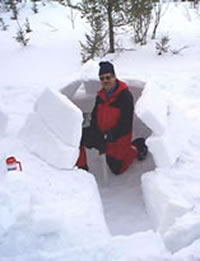|
|
A lone timber wolf greets
paddlers along the north shore
of Lake Superior, Canada
(Photo by Michael Neiger)
|
|
|
|
|
|
|
Movement
overcomes cold.
Stillness
overcomes heat.
-- Lao Tzu
604-531 B.C.
The snowshoe
and the toboggan
allow for
a level of comfort
in winter travel
that makes
backpacking
look spartan,
rigorous, and
downright unpleasant.
--Garrett and
Alexandra Conover
A Snow Walker's
Companion, 1995
Traveling...like this
is perpetual romance
for me.
This stump right here,
this birch,
this snowed up brook;
no, it is not these;
it is on and on
and forever on through
the bright white
wilderness
and the shadowed trees.
And best of all is
to stand on a ridge
and look ahead
over infinities of
nameless
solitary country
dreaming in
the short winter sun...
Sometimes keeps
calling,
on and on
to the farthest ridges
that lean
against the sky.
-- Elliot Merrick
True North
|
|
|
|
|
|
 |
By
Michael A. Neiger, Marquette, Michigan
Wilderness tripper:
backpacking, winter camping, swift-water canoeing
Web site URL: http://therucksack.tripod.com
• E-mail: mneiger@hotmail.com
Contents copyright © 1984-2007 by Michael A.
Neiger • All rights reserved.
|
|
| |
|

|
|
|
|
|
On a February,
1999
CUPG snowshoe trip
to Whiskey Bottle Lake,
Gary De Kock of
Fruitport, Michigan
bevel-cuts blocks of
snow for his Igloo in
anticipation of a
40-below night along
Kasubeek Creek,
Lake Superior
Provincial Park,
Ontario, Canada
(Photo by Gary De Kock) |
|
|
|
|
|
|
|
|
Winter-camping
Last updated on
December 20, 2005
|
|
|
|
|
|
|
|
|
|
|
|
|
|
|
|
|
|
|
|
|
|
|
|
|
|
|
|
For 100's of sources for wilderness tripping equipment
and supplies, visit the sources for
gear page on this Web site.
Trying to buy a new or used copy of a book, but can't
locate one? Want to find a library somewhere in the country
that will lend you the book at no cost? Then visit the handy
book finder page on this Web
site.
If you know of a useful
outdoor-related book, catalog, or Web site not listed on this
Web site, e-mail the book's title, subtitle, author, publisher,
date of publication, and short description; or the catalog's
address and phone number; or the Web site's URL to Michael
Neiger at mneiger@hotmail.com.
** Recommended
|
|
|
|
|
|
|
|
|
|
|
|
|
See the "how
to dress warm in foul weather" page in this Web site.
See the "how
to sleep warm in foul weather" page in this Web site.
See the "How
to prepare an MSR-type stove for cold-weather expeditioning"
on the Rations and Stove page on this Web site.
To avoid fuel-line freeze-ups and other
water-in-the-fuel problems, whether the water is introduced
when you refuel or from natural condensation in a partially-empty
fuel tank, treat your fuel with a water remover and fuel
system antifreeze such as Iso-HEET. Use according to the
instructions so you are using enough for the size of your
tank. Some large fuel tanks may require two or three bottles.
To minimize condensation in the fuel tank, always try to
keep your tank as full as possible.
To make your car easier to turn over
and easier to start in sub-zero temperatures, consider changing
the oil to a thinner, winter-weight oil recommended by the
manufacturer of your vehicle, possibly 5W30 weight oil.
This is essential in deep cold. Get
the biggest, high-amp battery that you can stuff in your
battery storage compartment. Visit an auto parts store that
has their batteries out on display and, after comparing
and contrasting the amp ratings vs. physical dimensions
of the batteries in their catalogs, get the highest-amp
one you can safely mount in your vehicle. This may take
some time and cash, but it is cheaper than the alternative:
having your vehicle towed a long distance, hotel fees, etc.
Make sure your anti-freeze can handle
40 below temps.
Make sure you have a spare gas
cap key too. This is much cheaper than having to go get
gas, or have your engine repaired because of vandals.
Consider having a block heater installed
in your engine. Even if your engine can not be jump started,
you can have it towed to a place with electricity where
the block heater will rewarm the engine within a few hours.
The alternative may be an expensive tow and then a two-day
thaw job in a heated garage, hotel fees, etc.
If you install an engine block heater,
carry a very long extension cord or two.
To make sure your tire pressure is correct
for winter driving, check it on a very cold day. Tire pressure
goes up on hot days and goes down on cold days. Make sure
your tires are properly inflated cold-weather driving.
String on lanyard and give to someone
else on trip.
In Canada, you must have a "Canadian
Nonresident Insurance Card" for your vehicle.
Call your insurance agent to get one.
Avoid short, thin cables.
Check engine, transmission, and front
and rear windshield washers
|
|
|
|
|
|
|
|
|
|
|
Return
to top of page | Return
to home page
In
God's wilderness lies the hope of the world,
the
great, fresh, unblighted, unredeemed wilderness.
—
John Muir 1838-1914, Alaska Wilderness, 1890
Content
Copyright © by Michael A. Neiger
All rights
reserved.
Comments?
Suggestions? Dead links? Inaccurate info?
Contact the
WebMaster at mneiger@hotmail.com
A
MacroMedia DreamWeaver 4 and Fireworks 4 production
|
|
|
|
|
|
|
|
|
|
|
|
|


